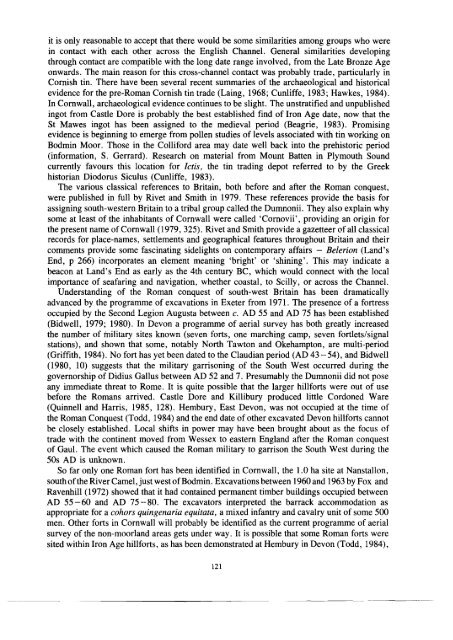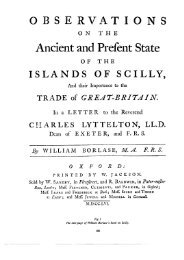Cornwall during the Iron Age and - Cornwall Archaeological Society
Cornwall during the Iron Age and - Cornwall Archaeological Society
Cornwall during the Iron Age and - Cornwall Archaeological Society
Create successful ePaper yourself
Turn your PDF publications into a flip-book with our unique Google optimized e-Paper software.
it is only reasonable to accept that <strong>the</strong>re would be some similarities among groups who were<br />
in contact with each o<strong>the</strong>r across <strong>the</strong> English Channel. General similarities developing<br />
through contact are compatible with <strong>the</strong> long date range involved, from <strong>the</strong> Late Bronze <strong>Age</strong><br />
onwards. The main reason for this cross-channel contact was probably trade, particularly in<br />
Cornish tin. There have been several recent summaries of <strong>the</strong> archaeological <strong>and</strong> historical<br />
evidence for <strong>the</strong> pre-Roman Cornish tin trade (Laing, 1968; Cunliffe, 1983; Hawkes, 1984).<br />
In <strong>Cornwall</strong>, archaeological evidence continues to be slight. The unstratified <strong>and</strong> unpublished<br />
ingot from Castle Dore is probably <strong>the</strong> best established find of <strong>Iron</strong> <strong>Age</strong> date, now that <strong>the</strong><br />
St Mawes ingot has been assigned to <strong>the</strong> medieval period (Beagrie, 1983). Promising<br />
evidence is beginning to emerge from pollen studies of levels associated with tin working on<br />
Bodmin Moor. Those in <strong>the</strong> Colliford area may date well back into <strong>the</strong> prehistoric period<br />
(information, S. Gerrard). Research on material from Mount Batten in Plymouth Sound<br />
currently favours this location for ktis, <strong>the</strong> tin trading depot referred to by <strong>the</strong> Greek<br />
historian Diodorus Siculus (Cunliffe, 1983).<br />
The various classical references to Britain, both before <strong>and</strong> after <strong>the</strong> Roman conquest,<br />
were published in full by Rivet <strong>and</strong> Smith in 1979. These references provide <strong>the</strong> basis for<br />
assigning south-western Britain to a tribal group called <strong>the</strong> Dumnonii. They also explain why<br />
some at least of <strong>the</strong> inhabitants of <strong>Cornwall</strong> were called `Cornovii', providing an origin for<br />
<strong>the</strong> present name of <strong>Cornwall</strong> (1979, 325). Rivet <strong>and</strong> Smith provide a gazetteer of all classical<br />
records for place-names, settlements <strong>and</strong> geographical features throughout Britain <strong>and</strong> <strong>the</strong>ir<br />
comments provide some fascinating sidelights on contemporary affairs — Belerion (L<strong>and</strong>'s<br />
End, p 266) incorporates an element meaning 'bright' or 'shining'. This may indicate a<br />
beacon at L<strong>and</strong>'s End as early as <strong>the</strong> 4th century BC, which would connect with <strong>the</strong> local<br />
importance of seafaring <strong>and</strong> navigation, whe<strong>the</strong>r coastal, to Scilly, or across <strong>the</strong> Channel.<br />
Underst<strong>and</strong>ing of <strong>the</strong> Roman conquest of south-west Britain has been dramatically<br />
advanced by <strong>the</strong> programme of excavations in Exeter from 1971. The presence of a fortress<br />
occupied by <strong>the</strong> Second Legion Augusta between c. AD 55 <strong>and</strong> AD 75 has been established<br />
(Bidwell, 1979; 1980). In Devon a programme of aerial survey has both greatly increased<br />
<strong>the</strong> number of Military sites known (seven forts, one marching camp, seven fortlets/signal<br />
stations), <strong>and</strong> shown that some, notably North Tawton <strong>and</strong> Okehampton, are multi-period<br />
(Griffith, 1984). No fort has yet been dated to <strong>the</strong> Claudian period (AD 43-54), <strong>and</strong> Bidwell<br />
(1980, 10) suggests that <strong>the</strong> military garrisoning of <strong>the</strong> South West occurred <strong>during</strong> <strong>the</strong><br />
governorship of Didius Gallus between AD 52 <strong>and</strong> 7. Presumably <strong>the</strong> Dumnonii did not pose<br />
any immediate threat to Rome. It is quite possible that <strong>the</strong> larger hillforts were out of use<br />
before <strong>the</strong> Romans arrived. Castle Dore <strong>and</strong> Killibury produced little Cordoned Ware<br />
(Quinnell <strong>and</strong> Harris, 1985, 128). Hembury, East Devon, was not occupied at <strong>the</strong> time of<br />
<strong>the</strong> Roman Conquest (Todd, 1984) <strong>and</strong> <strong>the</strong> end date of o<strong>the</strong>r excavated Devon hillforts cannot<br />
be closely established. Local shifts in power may have been brought about as <strong>the</strong> focus of<br />
trade with <strong>the</strong> continent moved from Wessex to eastern Engl<strong>and</strong> after <strong>the</strong> Roman conquest<br />
of Gaul. The event which caused <strong>the</strong> Roman military to garrison <strong>the</strong> South West <strong>during</strong> <strong>the</strong><br />
50s AD is unknown.<br />
So far only one Roman fort has been identified in <strong>Cornwall</strong>, <strong>the</strong> 1.0 ha site at Nanstallon,<br />
south of <strong>the</strong> River Camel, just west of Bodmin. Excavations between 1960 <strong>and</strong> 1963 by Fox <strong>and</strong><br />
Ravenhill (1972) showed that it had contained permanent timber buildings occupied between<br />
AD 55 — 60 <strong>and</strong> AD 75-80. The excavators interpreted <strong>the</strong> barrack accommodation as<br />
appropriate for a cohors quingenaria equitata, a mixed infantry <strong>and</strong> cavalry unit of some 500<br />
men. O<strong>the</strong>r forts in <strong>Cornwall</strong> will probably be identified as <strong>the</strong> current programme of aerial<br />
survey of <strong>the</strong> non-moorl<strong>and</strong> areas gets under way. It is possible that some Roman forts were<br />
sited within <strong>Iron</strong> <strong>Age</strong> hillforts, as has been demonstrated at Hembury in Devon (Todd, 1984),<br />
121




